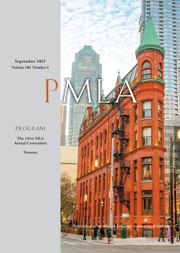No CrossRef data available.
Article contents
Shades of Red
Published online by Cambridge University Press: 01 September 2025
Abstract
An abstract is not available for this content so a preview has been provided. Please use the Get access link above for information on how to access this content.
Information
- Type
- Theories and Methodologies
- Information
- Copyright
- © 2025 The Author(s). Published by Cambridge University Press on behalf of Modern Language Association of America
References
Works Cited
Arendt, Hannah. Introduction. Illuminations: Essays and Reflections, by Benjamin, Walter, Schocken, 2007, pp. 1–58.Google Scholar
Armstrong, Aurelia. “Natural and Unnatural Communities: Spinoza beyond Hobbes.” British Journal for the History of Philosophy, vol. 17, no. 2, 2009, pp. 279–305.CrossRefGoogle Scholar
Barthes, Roland. Criticism and Truth. Edited and translated by Katrine Pilcher Keuneman, Bloomsbury, 2007.Google Scholar
Barthes, Roland. The Grain of the Voice: Interviews, 1962–1980. Translated by Coverdale, Linda, Hill and Wang, 1985.Google Scholar
Barthes, Roland. The Rustle of Language. Translated by Richard Howard, U of California P, 1989.Google Scholar
Barthes, Roland. Travels in China. Edited by Anne Herschberg Pierrot, translated by Andrew Brown, Polity Press, 2013.Google Scholar
Brecht, Bertolt. Prosa I. Edited by Jan Knopf et al., Suhrkamp, 1992. Vol. 16 of Werke: Große kommentierte Berliner und Frankfurter Ausgabe.Google Scholar
Brecht, Bertolt. Schriften I. Edited by Jan Knopf et al., Suhrkamp, 1992. Vol. 21 of Werke: Große kommentierte Berliner und Frankfurter Ausgabe.
Google Scholar
Buck-Morss, Susan. The Dialectics of Seeing: Walter Benjamin and the Arcades Project. MIT Press, 1991.Google Scholar
Field, Sandra Leonie. “Marx, Spinoza, and True Democracy.” Spinoza in Germany: Political and Religious Thought across the Long Nineteenth Century, edited by Jason Maurice Yonover and Kristin Gjesdal, Oxford UP, 2024, pp. 212–37.CrossRefGoogle Scholar
Field, Sandra Leonie. “The State: Spinoza’s Institutional Turn.” Spinoza: Basic Concepts, edited by André Santos Campos, Imprint Academic, 2015, pp. 142–54.Google Scholar
Han, Zhenjiang. “Jacques Rancière’s Left-Wing Literary Theory and Mao Zedong’s Thought on Literature and Art.” Contemporary French and Francophone Studies, vol. 28, no. 1, 2024, pp. 70–77.CrossRefGoogle Scholar
Hardt, Michael, and Negri, Antonio. Multitude: War and Democracy in the Age of Empire. Penguin, 2005.Google Scholar
Jameson, Fredric. The Political Unconscious: Narrative as a Socially Symbolic Act. Routledge, 2002.Google Scholar
Meyerhold, Vsevolod. Meyerhold on Theatre. Translated and edited by Braun, Edward, Bloomsbury, 2016.Google Scholar
Negri, Antonio. Insurgencies: Constituent Power and the Modern State. Translated by Maurizia Boscagli, U of Minnesota P, 1999.Google Scholar
Negri, Antonio. The Savage Anomaly: The Power of Spinoza’s Metaphysics and Politics. Translated by Michael Hardt, U of Minnesota P, 1991.Google Scholar
Nunes, Rodrigo. Neither Vertical nor Horizontal: A Theory of Political Organisation. Verso, 2021.Google Scholar
Nunes, Rodrigo. The Organization of the Organizationless: Collective Action after Networks. Mute Books, 2015.Google Scholar
Rancière, Jacques. Althusser’s Lesson. Translated by Battista, Emiliano, Bloomsbury, 2017.CrossRefGoogle Scholar
Rancière, Jacques. The Ignorant Schoolmaster: Five Lessons in Intellectual Emancipation. Translated by Kristin Ross, Stanford UP, 1991.Google Scholar
Wizisla, Erdmut. Walter Benjamin and Bertolt Brecht: The Story of a Friendship. Yale UP, 2009.CrossRefGoogle Scholar

